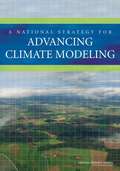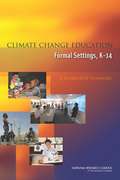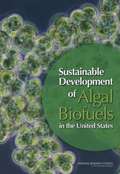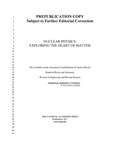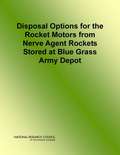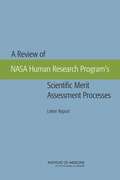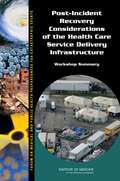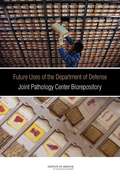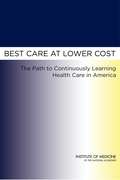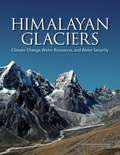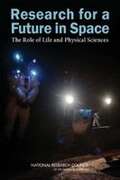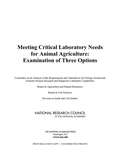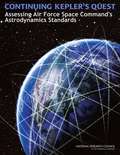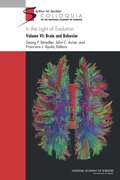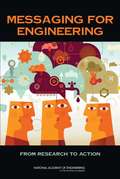- Table View
- List View
Adapting Agricultural Extension to Peacebuilding: Roundtable on Technology, Science, and Peacebuilding
by Andrew RobertsonSocieties have sought to improve the outputs of their agricultural producers for thousands of years. In the 19th and early 20th centuries, efforts to convey agricultural knowledge to farmers became known as extension services, a term adopted from programs at Oxford and Cambridge designed to extend the knowledge generated at universities to surrounding communities. Traditionally, extension services have emphasized a top-down model of technology transfer that encourages and teaches producers to use crop and livestock varieties and agricultural practices that will increase food production. More recently, extension services have moved toward a facilitation model, in which extension agents work with producers to identify their needs and the best sources of expertise to help meet those needs. On May 1, 2012, the Roundtable on Science, Technology, and Peacebuilding held a workshop in Washington, DC, to explore whether and how extension activities could serve peacebuilding purposes. The Roundtable is a partnership between the National Academy of Engineering (NAE) and the U. S. Institute of Peace (USIP). It consists of senior executives and experts from leading governmental organizations, universities, corporations, and nongovernmental organizations, was established in 2011 to make a measurable and positive impact on conflict management, peacebuilding, and security capabilities. Its principal goals are: To accelerate the application of science and technology to the process of peacebuilding and stabilization; To promote systematic, high-level communication between peacebuilding and technical organizations on the problems faced and the technical capabilities required for successful peacebuilding; and To collaborate in applying new science and technology to the most pressing challenges for local and international peacebuilders working in conflict zones.
A National Strategy for Advancing Climate Modeling
by Division on Earth and Life Studies Committee on a National Strategy for Advancing Climate Modeling Board on Atmospheric Sciences and ClimateAs climate change has pushed climate patterns outside of historic norms, the need for detailed projections is growing across all sectors, including agriculture, insurance, and emergency preparedness planning. A National Strategy for Advancing Climate Modeling emphasizes the needs for climate models to evolve substantially in order to deliver climate projections at the scale and level of detail desired by decision makers, this report finds. Despite much recent progress in developing reliable climate models, there are still efficiencies to be gained across the large and diverse U.S. climate modeling community. Evolving to a more unified climate modeling enterprise-in particular by developing a common software infrastructure shared by all climate researchers and holding an annual climate modeling forum-could help speed progress. Throughout this report, several recommendations and guidelines are outlined to accelerate progress in climate modeling. The U.S. supports several climate models, each conceptually similar but with components assembled with slightly different software and data output standards. If all U.S. climate models employed a single software system, it could simplify testing and migration to new computing hardware, and allow scientists to compare and interchange climate model components, such as land surface or ocean models. A National Strategy for Advancing Climate Modeling recommends an annual U.S. climate modeling forum be held to help bring the nation's diverse modeling communities together with the users of climate data. This would provide climate model data users with an opportunity to learn more about the strengths and limitations of models and provide input to modelers on their needs and provide a venue for discussions of priorities for the national modeling enterprise, and bring disparate climate science communities together to design common modeling experiments. In addition, A National Strategy for Advancing Climate Modeling explains that U.S. climate modelers will need to address an expanding breadth of scientific problems while striving to make predictions and projections more accurate. Progress toward this goal can be made through a combination of increasing model resolution, advances in observations, improved model physics, and more complete representations of the Earth system. To address the computing needs of the climate modeling community, the report suggests a two-pronged approach that involves the continued use and upgrading of existing climate-dedicated computing resources at modeling centers, together with research on how to effectively exploit the more complex computer hardware systems expected over the next 10 to 20 years.
Assessment of Agent Monitoring Strategies for the Blue Grass and Pueblo Chemical Agent Destruction Pilot Plants
by Committee on Assessment of Agent Monitoring Strategies for the Blue Grass Pueblo Chemical Agent Destruction Pilot PlantsJanuary 2012 saw the completion of the U. S. Army's Chemical Materials Agency's (CMA's) task to destroy 90 percent of the nation's stockpile of chemical weapons. CMA completed destruction of the chemical agents and associated weapons deployed overseas, which were transported to Johnston Atoll, southwest of Hawaii, and demilitarized there. The remaining 10 percent of the nation's chemical weapons stockpile is stored at two continental U. S. depots, in Lexington, Kentucky, and Pueblo, Colorado. Their destruction has been assigned to a separate U. S. Army organization, the Assembled Chemical Weapons Alternatives (ACWA) Element. ACWA is currently constructing the last two chemical weapons disposal facilities, the Pueblo and Blue Grass Chemical Agent Destruction Pilot Plants (denoted PCAPP and BGCAPP), with weapons destruction activities scheduled to start in 2015 and 2020, respectively. ACWA is charged with destroying the mustard agent stockpile at Pueblo and the nerve and mustard agent stockpile at Blue Grass without using the multiple incinerators and furnaces used at the five CMA demilitarization plants that dealt with assembled chemical weapons - munitions containing both chemical agents and explosive/propulsive components. The two ACWA demilitarization facilities are congressionally mandated to employ noncombustion-based chemical neutralization processes to destroy chemical agents. In order to safely operate its disposal plants, CMA developed methods and procedures to monitor chemical agent contamination of both secondary waste materials and plant structural components. ACWA currently plans to adopt these methods and procedures for use at these facilities. The Assessment of Agent Monitoring Strategies for the Blue Grass and Pueblo Chemical Agent Destruction Pilot Plants report also develops and describes a half-dozen scenarios involving prospective ACWA secondary waste characterization, process equipment maintenance and changeover activities, and closure agent decontamination challenges, where direct, real-time agent contamination measurements on surfaces or in porous bulk materials might allow more efficient and possibly safer operations if suitable analytical technology is available and affordable.
Climate Change Education in Formal Settings, K-14: A Workshop Summary
by Alexandra BeattyClimate change is occurring, is very likely caused by human activities, and poses significant risks for a broad range of human and natural systems. Each additional ton of greenhouse gases emitted commits us to further change and greater risks. In the judgment of the Committee on America's Climate Choices, the environmental, economic, and humanitarian risks of climate change indicate a pressing need for substantial action to limit the magnitude of climate change and to prepare to adapt to its impacts. A principal message from the recent National Research Council report, America's Climate Choices, this brief summary of how climate change will shape many aspects of life in the foreseeable future emphasizes the vital importance of preparation for these changes. The report points to the importance of formal and informal education in supporting the public's understanding of those challenges climate change will bring, and in preparing current and future generations to act to limit the magnitude of climate change and respond to those challenges. Recognizing both the urgency and the difficulty of climate change education, the National Research Council, with support from the National Science Foundation, formed the Climate Change Education Roundtable. The roundtable brings together federal agency representatives with diverse experts and practitioners in the physical and natural sciences, social sciences, learning sciences, environmental education, education policy, extension education and outreach, resource management, and public policy to engage in discussion and explore educational strategies for addressing climate change. Two workshops were held to survey the landscape of climate change education. The first explored the goals for climate change education for various target audiences. The second workshop, which is the focus of this summary, was held on August 31 and September 1, 2011, and focused on the teaching and learning of climate change and climate science in formal education settings, from kindergarten through the first two years of college (K-14). This workshop, based on an already articulated need to teach climate change education, provided a forum for discussion of the evidence from research and practice. The goal of this workshop was to raise and explore complex questions around climate change education, and to address the current status of climate change education in grade K-14 of the formal education system by facilitating discussion between expert researchers and practitioners in complementary fields, such as education policy, teacher professional development, learning and cognitive science, K-12 and higher education administration, instructional design, curriculum development, and climate science. Climate Change Education in Formal Settings, K-14: A Workshop Summary summarizes the two workshops.
Genome-Based Therapeutics
by Board on Health Sciences Policy Institute of Medicine Adam C. Berger Steve Olson Roundtable on Translating Genomic-Based Research for HealthThe number of new drug approvals has remained reasonably steady for the past 50 years at around 20 to 30 per year, while at the same time the total spending on health-related research and development has tripled since 1990. There are many suspected causes for this trend, including increases in regulatory barriers, the rising costs of scientific inquiry, a decrease in research and development efficiency, the downstream effects of patient expirations on investment, and the lack of production models that have successfully incorporated new technology. Regardless, this trajectory is not economically sustainable for the businesses involved, and, in response, many companies are turning toward collaborative models of drug development, whether with other industrial firms, academia, or government. Introducing greater efficiency and knowledge into these new models and aligning incentives among participants may help to reverse the trends highlighted above, while producing more effective drugs in the process. Genome-Based Therapeutics explains that new technologies have the potential to open up avenues of development and to identify new drug targets to pursue. Specifically, improved validation of gene-disease associations through genomics research has the potential to revolutionize drug production and lower development costs. Genetic information has helped developers by increasing their understanding of the mechanisms of disease as well as individual patients' reactions to their medications. There is a need to identify the success factors for the various models that are being developed, whether they are industry-led, academia-led, or collaborations between the two. Genome-Based Therapeutics summarizes a workshop that was held on March 21, 2012, titled New Paradigms in Drug Discovery: How Genomic Data Are Being Used to Revolutionize the Drug Discovery and Development Process. At this workshop the goal was to examine the general approaches being used to apply successes achieved so far, and the challenges ahead.
Sustainable Development of Algal Biofuels in the United States
by Division on Engineering and Physical Sciences Division on Earth and Life Studies Board on Energy and Environmental Systems National Research Council Board on Agriculture and Natural Resources Committee on the Sustainable Development of Algal BiofuelsBiofuels made from algae are gaining attention as a domestic source of renewable fuel. However, with current technologies, scaling up production of algal biofuels to meet even 5 percent of U.S. transportation fuel needs could create unsustainable demands for energy, water, and nutrient resources. Continued research and development could yield innovations to address these challenges, but determining if algal biofuel is a viable fuel alternative will involve comparing the environmental, economic and social impacts of algal biofuel production and use to those associated with petroleum-based fuels and other fuel sources. Sustainable Development of Algal Biofuels was produced at the request of the U.S. Department of Energy.
Nuclear Physics
by The Committee on the Assessment of Outlook for Nuclear PhysicsThe principal goals of the study were to articulate the scientific rationale and objectives of the field and then to take a long-term strategic view of U. S. nuclear science in the global context for setting future directions for the field. Nuclear Physics: Exploring the Heart of Matter provides a long-term assessment of an outlook for nuclear physics. The first phase of the report articulates the scientific rationale and objectives of the field, while the second phase provides a global context for the field and its long-term priorities and proposes a framework for progress through 2020 and beyond. In the second phase of the study, also developing a framework for progress through 2020 and beyond, the committee carefully considered the balance between universities and government facilities in terms of research and workforce development and the role of international collaborations in leveraging future investments. Nuclear physics today is a diverse field, encompassing research that spans dimensions from a tiny fraction of the volume of the individual particles (neutrons and protons) in the atomic nucleus to the enormous scales of astrophysical objects in the cosmos. Nuclear Physics: Exploring the Heart of Matter explains the research objectives, which include the desire not only to better understand the nature of matter interacting at the nuclear level, but also to describe the state of the universe that existed at the big bang. This report explains how the universe can now be studied in the most advanced colliding-beam accelerators, where strong forces are the dominant interactions, as well as the nature of neutrinos.
Disposal Options for the Rocket Motors From Nerve Agent Rockets Stored at Blue Grass Army Depot
by Division on Engineering and Physical Sciences Committee on Disposal Options for the Rocket Motors of Nerve Agent Rockets at Blue Grass Army Depot National Research Council Board on Army Science and TechnologyThe Blue Grass Chemical Agent-Destruction Pilot Plant (BGCAPP) is under construction near Richmond, Kentucky, two dispose of one of the two remaining stockpiles of chemical munitions in the United States. The stockpile that BGCAPP will dispose of is stored at the Blue Grass Army Depot (BGAD). BGCAPP is a tenant activity on BGAD. The stockpile stored at BGAD consists of mustard agent loaded in projectiles, and the nerve agents GB and VX loaded into projectiles and M55 rockets. BGCAPP will process the rockets by cutting them, still in their shipping and firing tube (SFT), between the warhead and motor sections of the rocket. The warhead will be processed through BGCAPP. The separated rocket motors that have been monitored for chemical agent and cleared for transportation outside of BGCAPP, the subject of this report, will be disposed of outside of BGCAPP. Any motors found to be contaminated with chemical agent will be processed through BGCAPP and are not addressed in this report. Disposal Options for the Rocket Motors From Nerve Agent Rockets Stored at Blue Grass Army Depot addresses safety in handling the separated rocket motors with special attention to the electrical ignition system, the need for adequate storage space for the motors in order to maintain the planned disposal rate at BGCAPP, thermal and chemical disposal technologies, and on-site and off-site disposal options. On-site is defined as disposal on BGAD, and off-site is defined as disposal by a commercial or government facility outside of BGAD.
A Review of NASA Human Research Program's Scientific Merit Processes
by Catharyn T. Liverman Institute of Medicine Larisa M. Strawbridge Board on Health Sciences Policy Andrea M. Schultz James A. Pawelczyk Committee on the Review of NASA Human Research Program's Scientific Merit Assessment ProcessesAt the request of NASA, an IOM committee reviewed NASA Human Research Program's (HRP's) Scientific Merit Assessment Processes for directed research. Directed research is commissioned or noncompetitively awarded research that is not competitively solicited because of specific reasons, such as time limitations or highly focused or constrained research topics. The scientific merit assessment processes have been developed by NASA to evaluate individual directed research tasks in order to ensure the scientific integrity of the HRP's directed research portfolio. The committee examined the HRP's current scientific merit assessment processes and conducted a public workshop to identify best practices among other federal agencies that use various assessment processes for similar types of directed research. Review of NASA Human Research Program's Scientific Merit Processes: Letter Report finds that the scientific merit assessment process used by the HRP for directed research is scientifically rigorous and is similar to the processes and merit criteria used by many other federal agencies and organizations - including the Department of Defense, National Institutes of Health, and the United States Department of Agriculture - for comparable types of research. This report also makes recommendations on ways to streamline and bolster the accountability and transparency of NASA's current processes.
Substance Use Disorders In The U.S. Armed Forces
by Committee on Prevention Diagnosis Treatment Management of Substance Use Disorders in the U.S. Armed ForcesProblems stemming from the misuse and abuse of alcohol and other drugs are by no means a new phenomenon, although the face of the issues has changed in recent years. National trends indicate substantial increases in the abuse of prescription medications. These increases are particularly prominent within the military, a population that also continues to experience long-standing issues with alcohol abuse. The problem of substance abuse within the military has come under new scrutiny in the context of the two concurrent wars in which the United States has been engaged during the past decade--in Afghanistan (Operation Enduring Freedom) and Iraq (Operation Iraqi Freedom and Operation New Dawn). Increasing rates of alcohol and other drug misuse adversely affect military readiness, family readiness, and safety, thereby posing a significant public health problem for the Department of Defense (DoD). To better understand this problem, DoD requested that the Institute of Medicine (IOM) assess the adequacy of current protocols in place across DoD and the different branches of the military pertaining to the prevention, screening, diagnosis, and treatment of substance use disorders (SUDs). Substance Use Disorders in the U. S. Armed Forces reviews the IOM's task of assessing access to SUD care for service members, members of the National Guard and Reserves, and military dependents, as well as the education and credentialing of SUD care providers, and offers specific recommendations to DoD on where and how improvements in these areas could be made.
Post-Incident Recovery Considerations of the Health Care Service Delivery Infrastructure
by Institute of Medicine Bruce M. Altevogt Theresa Wizemann Forum on Medical and Public Health Preparedness for Catastrophic Events Board on Health Sciences PolicyHealth systems and assets are a large part of the critical infrastructure of any community and are vital not only for the safety and well-being of its citizens, but also for the economic vitality, quality of life, and livelihood of the entire community. As part of its ongoing mission to foster dialogue among stakeholders and to confront the challenges inherent in ensuring the nation's health security, the Institute of Medicine (IOM) Forum on Medical and Public Health Preparedness for Catastrophic Events sponsored a town hall session at the 2012 Public Health Preparedness Summit. This event took place February 21-24 in Anaheim, California. In this session sponsored by the IOM, the focus of discussion was sustaining health care delivery beyond the initial response to a disaster and facilitating the full long-term recovery of the local health care delivery systems. Many elements required for recovery are also fundamental to the day-to-day operations of these systems. Investing in improved health care delivery systems, both financially and through collaborative capacity building, can enhance economic development and growth before a disaster, and also prove instrumental in sustaining services and recovering after a disaster. Post-Incident Recovery Considerations of the Health Care Service Delivery Infrastructure serves as a summary of the session and explains the value of regional capacity building; the importance of interagency, intergovernmental, and public-private collaboration; and the significant role that health care coalitions can play in ensuring resilient communities and national health security.
Future Uses of the Department of Defense Joint Pathology Center Biorepository
by Committee on the Review of the Appropriate Use of AFIP's Tissue Repository Following Its Transfer to the Joint Pathology CenterFounded during the Civil War as the Army Medical Museum, the Armed Forces Institute of Pathology (AFIP) amassed the world's largest collection of human pathologic specimens and was considered a premier consultation, education, and research facility by the end of the 20th century. Samples from the AFIP were instrumental in helping to solve public health mysteries, such as the sequence of the genome of the 1918 influenza virus that killed more than 40 million people worldwide. In 2005, the federal Base Realignment and Closure Commission recommended that the AFIP be closed, and its biorepository was transferred to the newly created Joint Pathology Center. During the transition, the Department of Defense asked the IOM to provide advice on operating the biorepository, managing its collection, and determining appropriate future use of specimens for consultation, education, and research. Future Uses of the Department of Defense Joint Pathology Center Biorepository, the IOM proposes a series of protocols, standards, safeguards, and guidelines that could help to ensure that this national treasure continues to be available to researchers in the years to come, while protecting the privacy of the people who provided the materials and maintaining the security of their personal information.
Best Care at Lower Cost
by Mark SmithAmerica's health care system has become too complex and costly to continue business as usual. Best Care at Lower Cost explains that inefficiencies, an overwhelming amount of data, and other economic and quality barriers hinder progress in improving health and threaten the nation's economic stability and global competitiveness. According to this report, the knowledge and tools exist to put the health system on the right course to achieve continuous improvement and better quality care at a lower cost. The costs of the system's current inefficiency underscore the urgent need for a systemwide transformation. About 30 percent of health spending in 2009--roughly $750 billion--was wasted on unnecessary services, excessive administrative costs, fraud, and other problems. Moreover, inefficiencies cause needless suffering. By one estimate, roughly 75,000 deaths might have been averted in 2005 if every state had delivered care at the quality level of the best performing state. This report states that the way health care providers currently train, practice, and learn new information cannot keep pace with the flood of research discoveries and technological advances. About 75 million Americans have more than one chronic condition, requiring coordination among multiple specialists and therapies, which can increase the potential for miscommunication, misdiagnosis, potentially conflicting interventions, and dangerous drug interactions. Best Care at Lower Cost emphasizes that a better use of data is a critical element of a continuously improving health system, such as mobile technologies and electronic health records that offer significant potential to capture and share health data better. In order for this to occur, the National Coordinator for Health Information Technology, IT developers, and standard-setting organizations should ensure that these systems are robust and interoperable. Clinicians and care organizations should fully adopt these technologies, and patients should be encouraged to use tools, such as personal health information portals, to actively engage in their care. This book is a call to action that will guide health care providers; administrators; caregivers; policy makers; health professionals; federal, state, and local government agencies; private and public health organizations; and educational institutions.
Transforming Glycoscience: A Roadmap for the Future
by Committee on Assessing the Importance Impact Of Glycomics GlycosciencesA new focus on glycoscience, a field that explores the structures and functions of sugars, promises great advances in areas as diverse as medicine, energy generation, and materials science, this report finds. Glycans--also known as carbohydrates, saccharides, or simply as sugars--play central roles in many biological processes and have properties useful in an array of applications. However, glycans have received little attention from the research community due to a lack of tools to probe their often complex structures and properties. Transforming Glycoscience: A Roadmap for the Future presents a roadmap for transforming glycoscience from a field dominated by specialists to a widely studied and integrated discipline, which could lead to a more complete understanding of glycans and help solve key challenges in diverse fields.
Himalayan Glaciers
by National Research Council Committee on Himalayan Glaciers, Hydrology, Climate Change, and Implications for Water Security Division on Earth and Life Studies Board on Atmospheric Sciences and ClimateScientific evidence shows that most glaciers in South Asia's Hindu Kush Himalayan region are retreating, but the consequences for the region's water supply are unclear, this report finds. The Hindu Kush Himalayan region is the location of several of Asia's great river systems, which provide water for drinking, irrigation, and other uses for about 1.5 billion people. Recent studies show that at lower elevations, glacial retreat is unlikely to cause significant changes in water availability over the next several decades, but other factors, including groundwater depletion and increasing human water use, could have a greater impact. Higher elevation areas could experience altered water flow in some river basins if current rates of glacial retreat continue, but shifts in the location, intensity, and variability of rain and snow due to climate change will likely have a greater impact on regional water supplies. Himalayan Glaciers: Climate Change, Water Resources, and Water Security makes recommendations and sets guidelines for the future of climate change and water security in the Himalayan Region. This report emphasizes that social changes, such as changing patterns of water use and water management decisions, are likely to have at least as much of an impact on water demand as environmental factors do on water supply. Water scarcity will likely affect the rural and urban poor most severely, as these groups have the least capacity to move to new locations as needed. It is predicted that the region will become increasingly urbanized as cities expand to absorb migrants in search of economic opportunities. As living standards and populations rise, water use will likely increase-for example, as more people have diets rich in meat, more water will be needed for agricultural use. The effects of future climate change could further exacerbate water stress. Himalayan Glaciers: Climate Change, Water Resources, and Water Security explains that changes in the availability of water resources could play an increasing role in political tensions, especially if existing water management institutions do not better account for the social, economic, and ecological complexities of the region. To effectively respond to the effects of climate change, water management systems will need to take into account the social, economic, and ecological complexities of the region. This means it will be important to expand research and monitoring programs to gather more detailed, consistent, and accurate data on demographics, water supply, demand, and scarcity.
Research for a Future in Space: The Role of Life and Physical Sciences
by Committee for the Decadal Survey on Biological Physical Sciences in SpaceDuring its more than 50-year history, NASA's success in human space exploration has depended on the agency's ability to effectively address a wide range of biomedical, engineering, physical sciences, and related obstacles. This achievement is made possible by NASA's strong and productive commitments to life and physical sciences research for human space exploration, and by its use of human space exploration infrastructures for scientific discovery. Research for a Future in Space: The Role of Life and Physical Sciences explains how unique characteristics of the space environment can be used to address complex problems in the life and physical sciences. This booklet also helps deliver both new knowledge and practical benefits for humankind as it embarks on a new era of space exploration. Research for a Future in Space: The Role of Life and Physical Sciences is based on the in depth report, Recapturing a Future for Space Exploration: Life and Physical Sciences Research for a New Era. To learn more about the future of space exploration, visit our catalog page and download this report for free.
Accelerating the Development of New Drugs and Diagnostics: Workshop Summary
by Steve OlsonAdvances in technologies and knowledge are creating new avenues for research and opportunities for the discovery and clinical development of innovative therapies and diagnostics. However, despite these opportunities, only a small fraction of investigational products are successfully developed into cures and therapies that can be accessed by patients. One response to the ever-widening gap between the number and promise of basic scientific discoveries and the translation of those discoveries into therapies is a renewed emphasis on collaborative approaches among federal agencies, academia, and industry, all directed at the advancement of the drug development enterprise. The newly developed Cures Acceleration Network (CAN)-a part of the National Center for Advancing Translational Sciences (NCATS) within the National Institutes of Health (NIH)-has the potential to catalyze widespread changes in NCATS, NIH, and the drug development ecosystem in general. On June 4-5, 2012, the IOM Forum on Drug Discovery, Development, and Translation held, at the request of NCATS, a workshop-bringing together members of federal government agencies, the private sector, academia, and advocacy groups-to explore options and opportunities in the implementation of CAN. Accelerating the Development of New Drugs and Diagnostics: Maximizing the Impact of the Cures Acceleration Network: Workshop Summary summarizes the workshop.
Key National Education Indicators: Workshop Summary
by Alexandra BeattyThe education system in the United States is continually challenged to adapt and improve, in part because its mission has become far more ambitious than it once was. At the turn of the 20th century, less than one-tenth of students enrolled were expected to graduate from high school. Today, most people expect schools to prepare all students to succeed in postsecondary education and to prosper in a complex, fast-changing global economy. Goals have broadened to include not only rigorous benchmarks in core academic subjects, but also technological literacy and the subtler capacities known as 21st-century skills. To identify the most important measures for education and other issues and provide quality data on them to the American people, Congress authorized the creation of a Key National Indicators System (KNIS). This system will be a single Web-based information source designed to help policy makers and the public better assess the position and progress of the nation across a wide range of areas. Identifying the right set of indicators for each area is not a small challenge. To serve their purpose of providing objective information that can encourage improvement and innovation, the indicators need to be valid and reliable but they also need to capture the report committee's aspirations for education. This report describes a workshop, planned under the aegis of the Board on Testing and Assessment and the Committee on National Statistics of the National Research Council. Key National Education Indicators is a summary of the meeting of a group with extensive experience in research, public policy, and practice. The goal of the workshop was not to make a final selection of indicators, but to take an important first step by clearly identifying the parameters of the challenge.
Meeting Critical Laboratory Needs for Animal Agriculture
by Division on Earth and Life Studies Board on Agriculture and Natural Resources Board on Life Sciences National Research Council Committee on an Analysis of the Requirements and Alternatives for Foreign Animal and Zoonotic Disease Research and Diagnostic Laboratory CapabilitiesOutbreaks of animal disease can have catastrophic repercussions for animal agriculture, the food supply, and public health. Rapid detection, diagnosis and response, as well as development of new vaccines, are central to mitigating the impact of disease outbreaks. The proposed National Bio- and Agro-Defense Facility (NBAF) is a next-generation laboratory for animal disease diagnostics, training, and research that would provide core critical components for defense against foreign animal and zoonotic disease threats. But it will be a major investment with estimated construction costs of $1.14 billion, as currently designed. Meeting Critical Laboratory Needs for Animal Agriculture: Examination of Three Optionsdiscusses the laboratory infrastructure needed to effectively address the threat posed by animal and zoonotic diseases and analyzes three options for creating this infrastructure: building NBAF as currently designed, building a scaled-back version of the NBAF, or maintaining current research capabilities at Plum Island Animal Disease Center while leveraging biosafety level-4 large animal capabilities at foreign laboratories.
Continuing Kepler's Quest
by National Research Council Aeronautics and Space Engineering Board Division on Engineering and Physical Sciences Committee for the Assessment of the U.S. Air Force's Astrodynamic StandardsIn February 2009, the commercial communications satellite Iridium 33 collided with the Russian military communications satellite Cosmos 2251. The collision, which was not the first recorded between two satellites in orbit--but the most recent and alarming--produced thousands of pieces of debris, only a small percentage of which could be tracked by sensors located around the world. In early 2007, China tested a kinetic anti-satellite weapon against one of its own satellites, which also generated substantial amounts of space debris. These collisions highlighted the importance of maintaining accurate knowledge, and the associated uncertainty, of the orbit of each object in space. These data are needed to predict close approaches of space objects and to compute the probability of collision so that owners/operators can decide whether or not to make a collision avoidance maneuver by a spacecraft with such capability. The space object catalog currently contains more than 20,000 objects, and when the planned space fence radar becomes operational this number is expected to exceed 100,000. A key task is to determine if objects might come closer to each other, an event known as "conjunction," and the probability that they might collide. The U.S. Air Force is the primary U.S. government organization tasked with maintaining the space object catalog and data on all space objects. This is a complicated task, involving collecting data from a multitude of different sensors-many of which were not specifically designed to track orbiting objects-and fusing the tracking data along with other data, such as data from atmospheric models, to provide predictions of where objects will be in the future. The Committee for the Assessment of the U.S. Air Force's Astrodynamic Standards collected data and heard from numerous people involved in developing and maintaining the current astrodynamics standards for the Air Force Space Command (AFSPC), as well as representatives of the user community, such as NASA and commercial satellite owners and operators. Preventing collisions of space objects, regardless of their ownership, is in the national security interested of the United States. Continuing Kepler's Quest makes recommendations to the AFSPC in order for it to create and expand research programs, design and develop hardware and software, as well as determine which organizations to work with to achieve its goals.
Disaster Resilience
by Committee on Increasing National Resilience to Hazards DisastersNo person or place is immune from disasters or disaster-related losses. Infectious disease outbreaks, acts of terrorism, social unrest, or financial disasters in addition to natural hazards can all lead to large-scale consequences for the nation and its communities. Communities and the nation thus face difficult fiscal, social, cultural, and environmental choices about the best ways to ensure basic security and quality of life against hazards, deliberate attacks, and disasters. Beyond the unquantifiable costs of injury and loss of life from disasters, statistics for 2011 alone indicate economic damages from natural disasters in the United States exceeded $55 billion, with 14 events costing more than a billion dollars in damages each. One way to reduce the impacts of disasters on the nation and its communities is to invest in enhancing resilience--the ability to prepare and plan for, absorb, recover from and more successfully adapt to adverse events. "Disaster Resilience: A National Imperative" addresses the broad issue of increasing the nation's resilience to disasters. This book defines "national resilience," describes the state of knowledge about resilience to hazards and disasters, and frames the main issues related to increasing resilience in the United States. It also provide goals, baseline conditions, or performance metrics for national resilience and outlines additional information, data, gaps, and/or obstacles that need to be addressed to increase the nation's resilience to disasters. Additionally, the book's authoring committee makes recommendations about the necessary approaches to elevate national resilience to disasters in the United States. Enhanced resilience allows better anticipation of disasters and better planning to reduce disaster losses-rather than waiting for an event to occur and paying for it afterward. "Disaster Resilience" confronts the topic of how to increase the nation's resilience to disasters through a vision of the characteristics of a resilient nation in the year 2030. Increasing disaster resilience is an imperative that requires the collective will of the nation and its communities. Although disasters will continue to occur, actions that move the nation from reactive approaches to disasters to a proactive stance where communities actively engage in enhancing resilience will reduce many of the broad societal and economic burdens that disasters can cause.
Using Science as Evidence in Public Policy
by Center For Education Division of Behavioral and Social Sciences and Education Kenneth Prewitt Committee on the Use of Social Science Knowledge in Public Policy Thomas A. Schwandt National Research Council Miron L. StrafUsing Science as Evidence in Public Policy encourages scientists to think differently about the use of scientific evidence in policy making. This report investigates why scientific evidence is important to policy making and argues that an extensive body of research on knowledge utilization has not led to any widely accepted explanation of what it means to use science in public policy. Using Science as Evidence in Public Policy identifies the gaps in our understanding and develops a framework for a new field of research to fill those gaps. For social scientists in a number of specialized fields, whether established scholars or Ph.D. students, Using Science as Evidence in Public Policy shows how to bring their expertise to bear on the study of using science to inform public policy. More generally, this report will be of special interest to scientists who want to see their research used in policy making, offering guidance on what is required beyond producing quality research, beyond translating results into more understandable terms, and beyond brokering the results through intermediaries, such as think tanks, lobbyists, and advocacy groups. For administrators and faculty in public policy programs and schools, Using Science as Evidence in Public Policy identifies critical elements of instruction that will better equip graduates to promote the use of science in policy making.
Scientific Review of the Draft Environmental Impact Statement: Drakes Bay Oyster Company Special Use Permit
by Committee on the Evaluation of the Drakes Bay Oyster Company Special Use Permit DEIS Peer ReviewIn May 2012, the National Park Service (NPS) asked the National Research Council to conduct a scientific review of a Draft Environmental Impact Statement (DEIS) to evaluate the effects of issuing a Special Use Permit for the commercial shellfish operation in Drakes Estero for a ten year time span. Drakes Bay Oyster Company (DBOC) currently operates the shellfish farm in Drakes Estero, part of Point Reyes National Seashore, under a reservation of use and occupancy that will expire on November 30, 2012 if a new Special Use Permit is not issued. Congress granted the Secretary of the Interior the discretionary authority to issue a new ten year Special Use Permit in 2009; hence, the Secretary now has the option to proceed with or delay the conversion of Drakes Estero to wilderness. To inform this decision, the NPS drafted an Environmental Impact Statement (EIS) for the DBOC Special Use Permit. Under the National Environmental policy Act (NEPA), as EIS is prepared to inform the public and agency decision-makers regarding the potential environmental impacts of a proposed federal action and reasonable alternatives. The Department of the Interior commissioned a peer review of the DEIS that was released in March 2012. Scientific Review of the Draft Environmental Impact Statement: Drakes Bay Oyster Company Special Use Permit reviews the scientific information presented in the DEIS that is used to determine the potential environmental impacts of a ten year extension of DBOC operations. In particular, this report responds to the following tasks given to the committee: assess the scientific information, analysis, and conclusions presented in the DEIS for Drakes Bay Oyster Company Special Use Permit, and evaluate whether the peer review of the DEIS is fundamentally sound and materially sufficient. Scientific Review of the Draft Environmental Impact Statement: Drakes Bay Oyster Company Special Use Permit focuses on eight of twelve resource categories considered in the DEIS: wetlands, eelgrass, wildlife and wildlife habitat, special-status species, coastal flood zones, soundscapes, water quality, and socioeconomic resources.
In the Light of Evolution
by National Academy Of Sciences Georg F. Striedter Francisco J. Ayala John C. AviseThe central goal of the In the Light of Evolution (ILE) series is to promote the evolutionary sciences through state-of-the-art colloquia--in the series of Arthur M. Sackler colloquia sponsored by the National Academy of Sciences--and their published proceedings. Each installment explores evolutionary perspectives on a particular biological topic that is scientifically intriguing but also has special relevance to contemporary societal issues or challenges. This book is the outgrowth of the Arthur M. Sackler Colloquium "Brain and Behavior," which was sponsored by the National Academy of Sciences on January 20-21, 2012, at the Academy's Arnold and Mabel Beckman Center in Irvine, CA. It is the sixth in a series of Colloquia under the general title "In the Light of Evolution." Specifically, In Light of Evolution: Brain and Behavior focuses on the field of evolutionary neuroscience that now includes a vast array of different approaches, data types, and species. This volume is also available for purchase with the In the Light of Evolution six-volume set.
Messaging for Engineering
by National Academy of Engineering Committee on Implementing Engineering MessagesFor those in the broad engineering community--those who employ, work with, and/or educate engineers, and engineers themselves--there is no need to explain the importance and value of engineering. They understand that engineers help make the world a better place for all, that they regularly grapple with important societal and environmental issues, and that the engineering process is every bit as creative as composing a symphony or crafting a piece of art. But the situation outside the engineering community is quite different. Studies have shown that most K-12 students and teachers have a limited appreciation of all the ways that engineering makes their lives better and, furthermore, that they have little understanding of what engineers do or of the opportunities that an engineering education offers. Messaging for Engineering supports efforts by the engineering community to communicate more effectively about the profession and those who practice it. This report builds on the 2008 NAE publication, Changing the Conversation: Messages for Improving Public Understanding of Engineering (CTC), which presented the results of a research-based effort to develop and test new, more effective messages about engineering. The new messages cast engineering as inherently creative and concerned with human welfare, as well as an emotionally satisfying calling. This report summarizes progress in implementing the CTC messages, but also recognizes that there is potential to galvanize additional action and thus suggests specific steps for major players in the engineering community to continue and build on progress to date. Many of the report's recommendations resulted from discussion at a December 2010 committee workshop that involved several dozen high-level decision makers representing key stakeholder groups in the engineering community.

